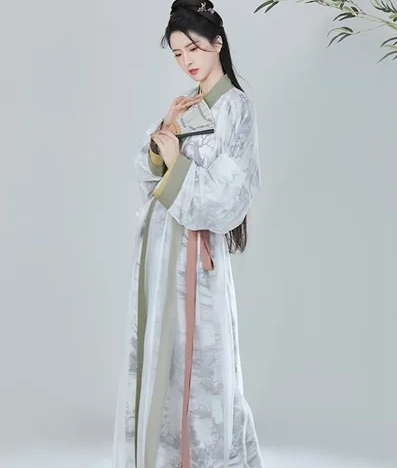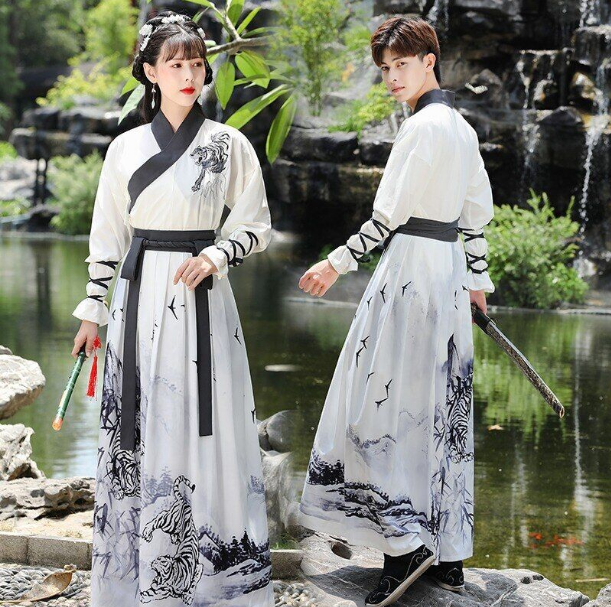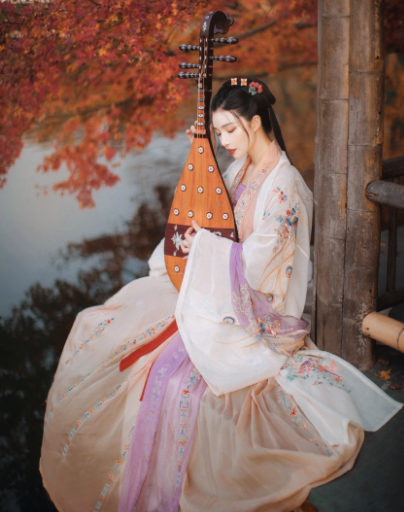Historical Evolution of Hanfu
The evolution of Hanfu, China’s traditional attire, paints a vivid picture of the country’s rich history and cultural shifts. This journey of Hanfu begins with its origins and spans across various dynastic changes, each contributing unique elements to its design.
Origins and Early Development
Tracing back to the earliest Chinese civilizations, Hanfu initially emerged as a reflection of societal hierarchies and norms. The Shang Dynasty (c. 1600–1046 BCE) notably marked the beginning of Hanfu’s evolution, where garments were simple yet functional. Archaeological findings, like jade carvings and bronze ware, depict the earliest styles of Hanfu, emphasizing practicality in the agricultural society.
During the Zhou Dynasty (1046–256 BCE), Hanfu saw a significant transformation. This era introduced the concept of “Yi” and “Shang,” denoting the upper and lower garments respectively. Silk, owing to its discovery and cultivation, became a staple material, symbolizing status and wealth. The use of silk in Hanfu is a testament to the era’s advancements in sericulture.

Influence of Dynastic Changes
Each subsequent dynasty brought its flavor to Hanfu, mirroring the era’s ethos and aesthetic preferences. The Han Dynasty (206 BCE – 220 CE), from which Hanfu derives its name, standardized this attire, making it a symbol of Han Chinese identity. The Han-style robes became more elaborate, featuring wider sleeves and a more flowing silhouette.
The Tang Dynasty (618–907 CE) introduced unprecedented diversity and flamboyance to Hanfu. Women’s dresses, known as “Tangzhuang,” became iconic for their vibrant colors and intricate patterns. This period saw the integration of foreign influences, as the Silk Road facilitated cultural exchange.
The Ming Dynasty (1368–1644 CE) streamlined Hanfu, focusing on refined elegance. The garments from this period are often regarded as the quintessential traditional Chinese attire, characterized by their straight lines and modest designs. The Ming-style Hanfu is frequently used in historical dramas and cultural revivals, symbolizing the quintessence of traditional Chinese fashion.
In each of these phases, Hanfu not only served as everyday wear but also as a canvas reflecting China’s artistic and technological advancements. From the luxurious silks of the Zhou Dynasty to the vibrant Tang robes and the elegant Ming attire, Hanfu’s evolution is a narrative of China’s cultural and historical journey.
Key Components of Traditional Hanfu
Traditional Hanfu, the classical attire of the Han Chinese, consists of several key components. Each piece serves not just a functional purpose but also embodies the rich cultural heritage of China. The attire typically comprises two primary sections: the upper garment and the lower garment, each with its distinct styles and variations.
Upper Garment Styles (Ru, Shan)
The upper garment of Hanfu, often known as ‘Ru’ or ‘Shan’, plays a pivotal role in the attire’s overall appearance. ‘Ru’ refers to the confucian-style robe, usually characterized by its cross-collar, tying on the right side. This style is a hallmark of traditional Hanfu and reflects the Confucian influence on Chinese culture, emphasizing modesty and respect.
On the other hand, ‘Shan’ is a more general term that encompasses a variety of jacket and robe styles. These can range from short jackets to long flowing robes, often worn over the ‘Ru’. The designs and fabrics of ‘Shan’ vary significantly, often indicating the wearer’s social status. For instance, the use of luxurious silk and intricate embroidery in ‘Shan’ was common among the nobility, as documented in historical texts and artworks.
Lower Garment Variations (Ku, Chang)
The lower garments in Hanfu, referred to as ‘Ku’ and ‘Chang’, offer a glimpse into the practical aspects of ancient Chinese clothing. ‘Ku’ denotes pants or trousers, which were essential for ease of movement, especially for men. In ancient times, the width and length of ‘Ku’ varied based on the wearer’s occupation and social status, with laborers often wearing shorter and more fitted ‘Ku’ for practicality.
‘Chang’, meaning skirt or a long flowing bottom, is another integral component. Skirts in Hanfu are typically full-length, wrapping around the waist and extending to the ankles or the ground. The elegance of ‘Chang’ is evident in its fluidity and grace, often highlighted during traditional dances and ceremonies. The use of various fabrics and colors in ‘Chang’ further adds to the Hanfu’s aesthetic appeal.
Both ‘Ku’ and ‘Chang’ are not just functional pieces but also carry significant cultural connotations, reflecting the social and historical context of their times. The versatility and adaptability of these garments over centuries underscore the enduring legacy of Hanfu in Chinese culture. For a more in-depth exploration of traditional Hanfu and its components, Wikipedia offers extensive information.
Materials and Textiles Used in Hanfu
The materials and textiles used in Hanfu are not just about utility; they are an embodiment of Chinese craftsmanship and cultural identity. Over the centuries, the choice of fabrics and decorative elements in Hanfu has evolved, reflecting both technological advancements and aesthetic shifts in Chinese society.
Common Fabrics: Silk, Linen, and Cotton
Silk, the most renowned fabric in Hanfu, is a symbol of ancient Chinese innovation. Originating from China’s sericulture, silk denotes luxury and status. Its smooth texture and lustrous appearance make it a favorite for high-quality Hanfu garments, especially for those of the upper class.
Linen, derived from the flax plant, offers a different appeal. It’s valued for its durability and comfort, especially in warmer climates. Linen’s breathability makes it a practical choice for everyday Hanfu wear, as it provides comfort while maintaining an elegant appearance.
Cotton, introduced later into Chinese textile production, became popular for its versatility and ease of maintenance. Cotton Hanfu is common among the general populace, known for its softness and durability. It’s especially prevalent in daily wear Hanfu, providing both comfort and practicality.
Decorative Elements: Embroidery and Patterns
Embroidery in Hanfu is not just decoration; it’s a storytelling medium. Intricate designs often depict historical tales, mythological creatures, and symbolic motifs like dragons, phoenixes, and flowers. The art of embroidery showcases the meticulous skill and artistic sensibilities of Chinese culture.
Patterns in Hanfu vary from simple geometric shapes to complex, intertwined designs. These patterns often carry cultural significance, with certain designs reserved for specific occasions or social statuses. The use of vibrant colors and diverse patterns in Hanfu makes each piece unique and reflective of the wearer’s identity.
The choice of materials and decorative elements in Hanfu goes beyond aesthetic appeal; it represents a deep connection to Chinese history and culture. The fabrics and designs used in Hanfu are a testament to China’s rich textile heritage. For more detailed information about the materials and textiles in Hanfu, Wikipedia provides a comprehensive overview.

Cultural Significance and Symbolism
Hanfu is much more than traditional Chinese clothing; it embodies a deep cultural significance and symbolism, resonating with the rich history and philosophical ideals of China. Each aspect of Hanfu, from its design to its colors, holds a deeper meaning, reflecting the values and beliefs of traditional Chinese culture.
Representation in Festivals and Ceremonies
In festivals and ceremonies, Hanfu takes on a role of paramount importance, serving as a bridge to China’s ancestral traditions. During the Lunar New Year, Mid-Autumn Festival, or traditional weddings, Hanfu is often the attire of choice, symbolizing respect for tradition and the celebration of Chinese heritage. Each festival has specific Hanfu styles associated with it, chosen for their symbolic significance and alignment with the event’s spirit.
Traditional ceremonies, such as the Confucian rite of passage ‘Guangong Shili’, also incorporate Hanfu as a key element. In these ceremonies, the attire represents a connection to ancient wisdom and cultural values, serving as a visual reminder of China’s enduring legacy and the continuity of its traditions.
Symbolic Meanings of Colors and Designs
In Hanfu, colors and designs are not mere aesthetic choices; they carry profound symbolic meanings. Red, for instance, is often associated with joy, luck, and prosperity, making it a popular choice for festive occasions and weddings. Blue and green typically symbolize tranquility and growth, respectively, and are commonly used in everyday Hanfu designs.
Designs in Hanfu, ranging from dragon motifs to floral patterns, are steeped in symbolism. Dragons, revered in Chinese culture, signify power and good fortune and are often incorporated into Hanfu worn by emperors or during significant events. Floral patterns, such as lotus or peony, symbolize purity and prosperity.
The cultural significance and symbolism of Hanfu are integral to understanding its role in Chinese society. It’s not just clothing but a canvas that captures the essence of Chinese history, philosophy, and art. For a deeper dive into the cultural significance and symbolism of Hanfu, you can explore Wikipedia.
Variations Across Different Dynasties
The Hanfu, through different dynasties in Chinese history, has undergone significant variations, each reflecting the unique cultural and aesthetic values of the time. These variations offer a fascinating glimpse into the evolving fashion and social norms of ancient China.
Tang Dynasty Elegance and Diversity
The Tang Dynasty is renowned for its cultural richness and openness, aspects vividly reflected in its Hanfu styles. Hanfu during this era was marked by its elegance and diversity, mirroring the cosmopolitan nature of Tang society. Women’s attire, especially, saw remarkable innovation with the introduction of the “Tangzhuang”, characterized by vibrant colors, wide sleeves, and high waistlines.
Men’s Hanfu in the Tang Dynasty also evolved, featuring broader sleeves and looser fits, reflecting the era’s preference for comfort combined with style. The Tang court’s interactions with neighboring cultures introduced exotic patterns and styles into Hanfu, making it one of the most diverse and culturally rich periods in Chinese fashion history.

Ming Dynasty’s Streamlined Designs
In contrast to the Tang Dynasty’s flamboyance, the Ming Dynasty favored more streamlined and refined Hanfu designs. This era saw a return to traditional values and simplicity in clothing. Men’s attire was typically composed of straight-lined robes, while women’s Hanfu emphasized a slender silhouette, often accompanied by intricate yet subtle patterns.
The Ming Dynasty also brought advancements in weaving and dyeing techniques, leading to higher quality fabrics and more durable colors. These improvements significantly enhanced the elegance and practicality of Ming Hanfu, making it a symbol of refined taste and sophistication in traditional Chinese fashion.
The variations in Hanfu across these dynasties not only showcase the evolving fashion trends but also reflect the changing societal values and cultural interactions of each period. For further insights into the historical variations of Hanfu, Wikipedia offers a detailed exploration.
Modern Revival and Adaptation
The modern revival and adaptation of Hanfu reflect a growing interest in traditional Chinese culture, particularly among the younger generation. This revival is not just a return to the past but an innovative blending of ancient styles with contemporary fashion sensibilities.
Contemporary Fashion Influences
Contemporary fashion has significantly influenced the adaptation of Hanfu. Modern designers often infuse traditional Hanfu styles with current trends, creating outfits that are both culturally rich and fashion-forward. Elements like asymmetrical cuts, modern prints, and new fabric technologies are being incorporated, resulting in a fusion that resonates with today’s youth.
Additionally, the global fashion scene’s growing interest in diversity and cultural heritage has elevated Hanfu’s status. International fashion shows and cultural exchanges frequently showcase Hanfu, introducing its elegance and historical significance to a wider audience.
Role in Cultural Identity and Preservation
Hanfu plays a crucial role in the preservation and promotion of Chinese cultural identity. Its resurgence has sparked renewed interest in China’s historical heritage, with many seeing it as a symbol of national pride and identity. Wearing Hanfu, especially during traditional festivals and ceremonies, has become a way for people to connect with their roots and celebrate their cultural legacy.
Moreover, the Hanfu movement has led to a greater appreciation of traditional Chinese arts and crafts, as the demand for authentic, high-quality Hanfu has revived ancient textile techniques and embroidery skills. This revival not only preserves these traditional arts but also provides a platform for artisans to innovate and keep their crafts alive in the modern world.
The modern adaptation of Hanfu is a testament to the dynamic and evolving nature of cultural traditions. It illustrates how ancient practices can find new relevance and expression in contemporary society. For more detailed information on the modern revival of Hanfu, Wikipedia offers extensive insights.